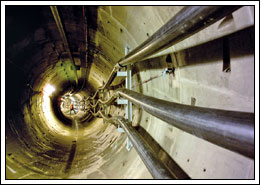
As an integral part of
power infrastructure,
cables have an
indispensable role in
reaching power from
generating stations to local
consumption points. This
special story by
Venugopal Pillai, takes a
closer look at two
distinctive features of the
cables industry—the
muddle in the low-voltage
segment and the exciting
opportunities in store for
extra high-voltage cables.
Like any other electrical equipment segment, the
cables industry is very diverse in terms of its product
range and level of quality. The cables industry
covers the entire spectrum from low-voltage
home wiring cables used at the final consumption point
to extra high voltage (EHV) cables used in subtransmission
and distribution lines. The market
segmentation is inverted in that there is a plethora of small
manufacturers at the lower end while the sophisticated
EHV cables category is reserved only for the top-end class
that typically include large domestic and multinational
companies.
The electric cables industry is perhaps the most critical as it
covers, in conjunction with conductors, the entire value
chain from power generation plant to power socket. Apart
from cables used in the power supply chain, specialty cables
are also needed by the industrial sector for use in heavy
machinery, automobiles, consumer goods, etc.
Growth in the cables industry is linked directly to the
investment in the power sector. Further, the fortunes of the low-voltage cables segment are also governed by prospects in
the consumption sectors, mainly domestic and commercial
real estate. To a significant extent, the consumption of
specialty cables also depends on patterns prevailing in the
industrial (manufacturing) sector.
In this special story, we aim to discuss the two ends of the
spectrum. On one, we have the low-voltage building wire
segment that has always been an area of concern; and on the
other is the fast-emerging EHV cables that is today the
biggest business opportunity.
A. LOW-VOLTAGE CABLES
Also referred to as building wires, this is the largest segment
in the electric cables industry, at least in terms of number of
manufacturers and consumers. The estimated market size of
the building wire industry is Rs.10,000 crore with annual
growth pegged at 15 per cent. Unfortunately, this segment is
grossly unregulated with anarchy prevailing rampantly. This
segment is overcrowded with local players that pay no heed
to quality or safety. Players in the unorganized sector are
cognizant of the huge demand potential and can always serve
this growing market, but competing with local players on the
price front is impossible.
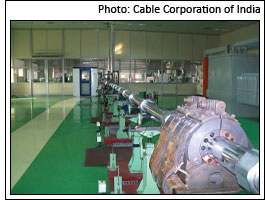
The obvious reason why local brands continue to flourish
in the market is that there is a market for it. Consumers are
indeed buying these wires, either inadvertently or willfully.
Products made by a reputed manufacturer could be between
40 to 60 per cent higher than that of a local brand. Products
made by marginal players in the unorganized sector
obviously use inferior material - be it copper or the PVC
insulation. The copper used is not oxygen-free, which results
in poor conductivity. Worse is that the insulation is made
from cheap polymer, which can pose a grave hazard to human
lives, in case of accidental fire. Studies have shown casualties
during a short-circuit induced fire are not because of the fire
per se but due to the toxic fumes emanated during the burning
of the insulation material. Flame retardant cables of the
highest quality are produced only by organized sector players
but they come at a price. Unorganized players simply cannot
afford to produce quality material at prices that they offer.
It is encouraging to note that over the past decade, home
owners and real estate developers are getting increasingly
conscious of the safety element of building wires. Aggressive
awareness campaigns launched by reputed manufacturers
and trade associations are responsible for this change in
mindset. It is estimated that in the four metropolitan and
tier-1 cities, organized sector players have a market share of
90 per cent in the building wire segment. However, when one
moves to tier-II and tier-III cities, this share drops sharply to
30 per cent. At a national level, the share of unorganized
sector players is around 40 per cent.
As discussed above, the highest percolation of unorganized
sector manufacturers is in tier-II and tier-III cities, and of
course the rural markets. In these areas, when electrical wiring is done, the choice of wires is usually left to
electricians and not property owners. Electricians would
compromise on quality because it helps them tender an
"affordable" and "reasonable" estimate to the property
owners. Most importantly, the ill effects of using an inferior
electrical cable are not felt immediately. For the property
owner, the use of an inferior or superior cable makes no visible
difference. It therefore comes as little surprise that electric
cables of superior quality have a market share of only 30 per
cent in semi-urban and rural areas.
Another reason why superior cables are not used in such
areas is the sheer unavailability of these products. Local
producers manufacture and sell within the state and hence
have much lower distribution costs compared to that
incurred by a large manufacturer that has to bring in the
products from outside the state. This economic disadvantage
coupled with the perceived "brand indifference" in non-urban
areas in fact makes reputed manufacturers shun these
markets. An industry source indicated that reputed brands
tend to focus more on urban areas and it is economically
unviable for them to compete with local players. Moreover,
the business margins on 1.1kV electric cable industry are not
very high as compared to higher value-added products like
high voltage and specialty cables.
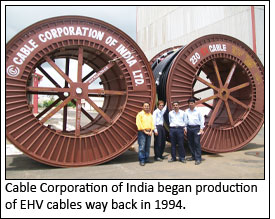
Sanjay Aggarwal, Chairman & CEO, Paramount
Communications Ltd, in an earlier interaction with Electrical
Monitor, agreed that the Indian consumer market as a whole is
generally low on technical awareness, especially for products
as commoditized as wires. What is recommended by the
dealer or the electrician is generally accepted, and the dealers
and electricians in turn promote those products with which
they get greater financial incentives, rather than on the basis
of safety and quality. Most contractors and builders too are
more concerned with keeping their costs minimal, and they
have a wide array of cheap, low quality brands to choose
from, Aggarwal noted.
It is also worth noting that RGGVY has resulted in a sharp
increase in the number of electrified households,
necessitating building wires and wiring devices. This growth
in the rural demand for electric cables has further spawned
local players in the market. The semi-urban and rural market
will tilt in favour of quality products only with growing
awareness. It is only when the buyer insists on safe and
quality products-and is willing to pay for the quality-will
there be sustainable demand for products by organized sector
players. Currently, the situation is not encouraging but could
improve with time. As of now, an estimated Rs.3,000 crore of
spurious building wires are sold to gullible customers every
year, an industry player noted.
Building wires, especially in the residential segment, is a
"low involvement" product as far as decision-making is
concerned. During home renovation or construction, details
like the colour the paint of the type of switches might get
more attention that a crucial input like electric wires.
Builders might want to willfully compromise on the quality
of wires as an act of cost-cutting, and with a view to
maximizing their profits.
While it must be admitted that India has had a tough time
with the low-end building wire segment, thanks to the
overwhelming presence of the unorganized sector, there is
still some reason to cheer. As mentioned earlier, awareness of
quality cables is on the rise thanks to widespread
promotional activities by large manufacturers and also trade
associations. The share of marginal players in the building
wire segment is likely to plummet in the coming years. In a
recent interaction with Electrical Monitor, R. Ramakrishnan,
CEO, Polycab Group, estimated that in the next three years
the share of unorganized sector players should recede to 25
per cent and settling to 15 per cent in the long term.
The declining share of the unorganized sector would
obviously mean that the market for building wires will be
controlled by reputed manufacturers. This should also result
in big names in the cables industry that have shunned the
building wire business-finding it non-remunerative to
compete with local marginal players wanting to return to it.
In earlier interactions by Electrical Monitor with leading cable
manufacturers, it was learnt that KEI Industries was keen to
scale up production of low-voltage cables, while Lapp India, a multinational specializing in specialty cables, was keen to
enter the building wire segment.
The low-voltage cable industry is admittedly in a mess at
the moment, but the coming years should progressively see
positive change.
PART B: EHV CABLES
EHV or extra high-voltage cables represent an emerging area
of opportunity in the Indian cables industry. EHV cables are
those that are designed to carry very large amount of electric
current, several times higher than high-, medium- or lowvoltage
cables. Although there is no standard definition
available for EHV cables, in the Indian context, cables with a
rating of over 220kV (for alternating current or AC) are
classified as EHV cables. An industry player pointed out that
the classification of EHV cables has evolved over time and
reflects the progress of technology worldwide. Some years
ago, even cables of 132kV rating were considered EHV cables
and earlier, even 66kV cables merited the classification of
EHV.
EHV cables fit perfectly into India's current power scenario
and given the intrinsic value offered by EHV cables, the
market is expected to grow substantially. Extra high voltage
cables are normally used during bulk power transfer, which is
in sub-transmission and distribution lines. EHV is used in
areas where it is difficult or unfeasible to install overhead
power conductors. EHV cables however involve higher initial
costs. They cost more and also their laying, which is done
underground, can be cumbersome. All the same, the life-cycle
cost of EHV cables is strikingly low.
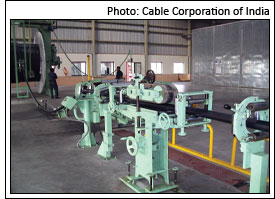
The obvious advantage of underground EHV cables is that
they are invisible and hence there is no physical hindrance
whatsoever. Secondly, EHV cables have very long operating
life and are virtually maintenance free. EHV cables also can
play a very important part in reducing commercial power
losses. Unlike in the case of bare overhead conductors from
which electricity can be tapped (stolen), no power theft is
possible with EHV cables. Also, India's cities are rapidly
expanding. Urbanization in India that stood at 26 per cent in
1991 touched 31 per cent in 2011. By 2020, as reliable
forecasts indicate, around 40 per cent of the country's
population will dwell in urban centres.
Urbanization leads to not only additional load from
existing demand centres, but also the creation of new load
centres. All this warrants augmentation of transmission lines
capacity and even creation of new T&D infrastructure.
These days, securing right-of-way is becoming increasingly
difficult not only in metropolitan and tier-I cities but also in
tier-II and tier-III cities. Power distribution through EHV
cables is becoming the first priority wherever aerial cables are
impossible to install. It must also be noted that power
utilities, with a clear goal of obviating power theft, are
nowadays unconditionally insisting on underground EHV
cables.
Technology: Local technology for producing EHV cables
(above 220kV) did not exist in India, primarily because there
was no perceived need for such cables. According to
information available with Electrical Monitor, the tilt towards
EHV cables began surfacing in the mid-1990s. In 1994, Cable
Corporation of India Ltd (CCI) produced 220kV cables for
the first time in the country. This was then the highest rating
cable produced in the country and defined a new paradigm.
Till then, cables of 132kV were normally considered to be of
the EHV type. CCI continued upgrading its technology and
began producing 230kV cables. Currently CCI is upgrading
its technical competency to produce 440kV cables.
Foreign players: Over the past five years or so, the Indian
EHV cable segment has seen enormous interest from large
multinational names. Foreign names like Nexans, Prysmian,
LS Cable, Brugg Kabel, etc have identified India's EHV cable
industry as a huge business opportunity. These
multinationals have entered India through strategic joint
ventures with leading Indian names like Polycab, Finolex,
Ravin Cables, etc. Although India permits 100 per cent FDI
for manufacture of cables, most foreign entities have
preferred the joint venture route. The Indian market for HV
and EHV cables though very large is still represented by
government utilities. Marketing and distribution of cables is
therefore a skill that is acquired only by sustained presence in
the industry. It is perhaps with this in mind that strategic JVs
are being formed with the foreign partner bringing in the
technology and the Indian partner providing the local
expertise. Apart from these, there are cases where the foreign
partner will only provide technical expertise without any financial (equity) participation. In all this, there are even
Indian companies that are producing EHV cables without
any formal technical collaboration. There is also at least one
instance where Indian entities are undertaking dealerships to
source and distribute EHV cables manufactured by overseas
companies.
Here is a brief description of emerging entrants in the EHV
cables segment, largely relating to cables exceeding 220kV.
While some companies have begun production, others are in
the process.
Finolex J-Power: In early 2008, Finolex Cables Ltd,
amongst India's largest player in the power and telecom
cables industry, entered into a joint venture agreement with
J-Power Systems Corporation of Japan for setting up a
greenfield manufacturing facility in India for EHV cables up
to 500kV. Named Finolex J-Power Systems Pvt Ltd, the JV
would also undertake "connectorization" of complete circuits
and supply of jointing kits. In September 2011, the greenfield
plant at Shirwal near Pune in Maharashtra was
commissioned. The JV has also started participating in the
tenders invited by government utilities. The copper rods
required in the manufacture of EHV cables are being supplied
by Finolex Cables Ltd, it is learnt. JPower Systems represents
a conglomeration of two Japanese cable giants Hitachi Cable
and Sumitomo Electric Industries.
Polycab-Nexans: In March 2009, global cable
manufacturing company Nexans, headquartered in France
teamed up with Polycab Wires Pvt Ltd to set up a greenfield
manufacturing unit at Vadodara in Gujarat.
However, it is now reliably learnt that Nexans has decided
to pull out of the joint venture following considerable delays
in setting up of the manufacturing plant. In an email
exchange with Electrical Monitor, a Nexans spokesperson
confirmed that the decision to terminate the joint venture in
India was made due to "several issues that could not be solved
in a decent period of time." Elaborating on some of the
reasons, the official cited that the JV faced major difficulties
to get authorizations to build the facility and start
operations. The JV is no longer in force, the official
reaffirmed.
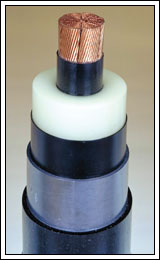
The two partners had planned to invest Rs.400 crore in the
facility to make EHV cables apart from manufacturing and
marketing special cables for the shipbuilding, material
handling, railway and wind power industries. Nexans was to
hold 50 per cent equity capital plus one equity share and was
to manage the joint venture company in close cooperation
with Polycab.
Nexans has commercial operations in India but no
manufacturing facility as yet. The Nexans official further
explained, "Nexans will consider any opportunities that may
arise in the future to develop its operations in India."
KEI-Brugg Kabel: In November 2010, KEI Industries
inaugurated its EHV cable manufacturing plant at
Chopanki in Rajasthan. The unit is currently capable of
producing cables from 66kV to 220kV. The facility was set
up with technical collaboration (without financial
participation) with Brugg Kabel AG of Switzerland, a
global manufacturer of EHV cables, jointing kits and cable
accessories.
Ravin-Prysmian: In February 2010, Ravin Cables Ltd signed a joint venture with The Prysmian Group, Italy, a
global leader in the energy and telecommunications cables
industry for manufacture of all kinds of LV, MV, HV, EHV and
other specialty cables. Prysmian Group will take a 51 per cent
stake in Ravin Cables, with the other 49 per cent stake
remaining in the hands of the current promoters, with Vijay
Karia being the Chairman & Managing Director. Prysmian
manufactures EHV cables up to 500kV at its global
manufacturing facilities.
KEC International: In July 2012, KEC International Ltd
announced that it completed the first phase of its hightension
cable unit at Vadodara. The greenfield unit will
currently produce cables up to 33kV at an annual capacity of
1,800 km. In the second phase, KEC will start producing EHV
cables (up to 220kV) at the Vadodara unit. It will also produce
cables in the 400kV class in a phased manner. On completion
of both phases, the total cable production capacity of the
Vadodara unit will be around 4,000 km per year. It may be
recalled that RPG Cables Ltd, part of the RP Goenka Group,
was merged with KEC International in October 2009.
Cable Corporation of India: As discussed earlier, Cable
Corporation of India (CCI) has been the traditional leader of
EHV cables in India. It began production of 220kV cables way
back in 1994 and subsequently started production of 230kV
cables. CCI does not have a technical collaboration for its
EHV cables. The company recently upgraded its
manufacturing facilities for production of 400kV EHV
cables. Production of 400kV cables has started and testing is
underway.
Diamond Power: Gujarat-based Diamond Power
Infrastructure Ltd, formerly Diamond Cables Ltd, currently
produces India's highest-rating EHV cables. In June 2011,
DPIL set up a modern EHV cable factory at an outlay of Rs.85
crore with technical support from Malliefer of France. The
plant has a capacity to produce EHV cables up to 500kV,
making Diamond Power among the only seven
manufacturers in the world to have such range of extra high
voltage cables.
Shree NM Electricals: Shree NM Electricals, amongst
India's largest distributor of electrical equipment, has tied up
with China-based Chongqing Yuneng Tai Shan Cable & Wire
Company Ltd for supply of EHV cables in India. Chongqing
Yuneng Tai Shan is believed to be the largest manufacturer of
EHV cables in China and markets its cables under the
"Taishan" brand. It produces cables up to 500kV and also
aluminium conductors. Its 500kV cable capacity alone is said
to be 1,000 km per year.
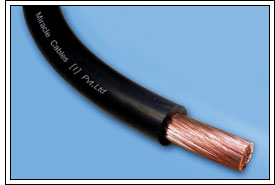 EHV IS THE WAY FORWARD
EHV IS THE WAY FORWARD
The Indian EHV cables market is yet nascent and the
collective indigenous capability to produce cables of above
220kV is still embryonic. The first known instance of
deploying EHV cables exceeding 220kV in India was
somewhere in the mid-1990s. Over the past five years,
reputed domestic players are extending their competency to
cover EHV cables. The demand potential, as universally
agreed, is vast. Transmission and distribution utilities are
showing a marked preference to EHV cables, in cognizance of
their advantages over conventional overhead conductors.
Currently, there are around six Indian companies that are
acquiring the capability of manufacturing EHV cables of
rating 220kV and above. In the coming years, more
companies would enter the fray to capitalize on the business
opportunities. While Indian companies would rely on the
technology available in the developed world, the tie-ups
would not necessarily be financial. As one local cable
manufacturer explained, EHV cable technology is also
available with cable machinery manufacturers. As such, one
need not always go in for financial collaborations with cable
producing companies. Diamond Power Infrastructure, for
instance, entered into an agreement with Malliefer of France,
a reputed machinery manufacturer. Diamond is perhaps the
only Indian company, competent to produce EHV cables
even up to 550kV. Hence, Indian companies could have
technical (non-financial) collaborations with either cable
producing companies or cable machinery manufacturers.
On the other hand, foreign cable producing companies are
only too keen on enter India; they have established timetested
technology but do not have a local market as big as
India's. In European countries, the demand for conventional
EHV cables is drying up and technology is idling.
Multinational cable manufacturers are seen to be more
inclined on equity-backed joint ventures as it gives them
better returns, even in the face of higher risks. As observed
earlier, even through 100 per cent FDI is allowed,
multinationals are keen to tying up with local manufacturers
to ensure that global technology is complemented by local
marketing expertise. The coming years will see a large flow of
foreign technology into the Indian EHV cable market,
including pure technical agreements and financial
collaborations.The EHV cable market potential during the
past five years was around 300 km per year and during the
current fiscal year ending March 2013, this is expected to
reach 500 km. Experts believe that widespread investment in
the power T&D sector will lead to EHV cables recording a
growth of even 25 per cent per year in the medium term. Over
the next five years, the annual Indian EHV market could well
be in the region of 1,500-2,000 km.
EHV cables is clearly the next big story, and most likely the
next growth story,in India's power cable market.